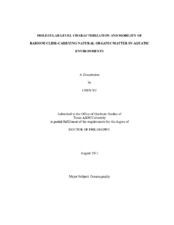| dc.description.abstract | Radionuclides, 129I and 239,240Pu, are major products or by-products of nuclear fission and among the top risk drivers for waste disposal at the Savannah River Sites (SRS) and Rocky Flats Environmental Technology Sites (RFETS), respectively, due to their perceived mobility in the environment, excessive inventory, toxicity, and long half-life. The objective of this study is to investigate the role of natural organic matter in retarding or facilitating the migration of 129I and 239,240Pu in the Department of Energy (DOE) sites.
Measurements of 127I and 129I in humic acids (HAs) and fulvic acids (FAs) obtained by five successive alkaline, two glycerol and one citric acid-alkaline extractions, demonstrated that these extractable humic substances (HS) together account for 54-56 percent and 46 percent of the total 127I and 129I in the soil, respectively. The variations among 127I and 129I concentrations, isotopic ratios (129I/127I), chemical properties of all these humic substances indicated iodine was bound to a small-size aromatic subunit (~10 kDa), while the large-size subunit (~90 kDa), which likely linked the small-size unit through some weak chemical forces, determined the relative mobility of iodine bound to organic matter.
Soil resuspension experiments simulating surface runoff or stormflow and erosion events were conducted with soils collected from SRS. Results showed that 72-77 percent of the newly-introduced I- or IO3- were irreversibly sequestered into the organic-rich soil, while the rest was transformed into colloidal and dissolved organo-iodine by the soil. The resulting iodine remobilization contradicts the conventional view that considers only I- or IO3- as the mobile forms.
Quantitative structure analysis by 13C DPMAS NMR and solution state 1H NMR on these humic substances indicate that iodine is closely related to the aromatic regions containing esterified products of phenolic and fomic acid or other aliphatic carboxylic acids, amide functionalities, quinone-like structure activated by electron-donating groups (e.g., NH2) or hemicelluloses-lignin-like complex with phenyl-glycosidic linkage. The micro-molecular environment, such as the hydrophobic aliphatic periphery hindering the active aromatic cores and the hydrophilic polysaccharides favoring its accessibility towards hydrophilic iodine species, play another key role in the interactions between iodine and SOM.
NMR spectra of the colloidal organic Pu carrier which can potentially be released from the soil during the surface runoff or stormflow showed Pu was transported, at sub-pM concentrations, by a cutin-derived soil degradation products containing siderophore-like moieties and virtually all mobile Pu. | en |


